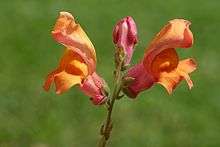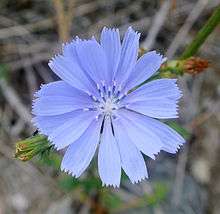Edible flower

Edible flowers are flowers that can be consumed safely. Flowers are part of many regional cuisines, including Asian, European, and Middle Eastern cuisines.[1]
Uses

With their powerful and unique flavors, textures and colors, edible flowers have gained popularity as a creative and innovative ingredient for the culinary world.[2] Flowers are added to foods to provide taste, aroma, and color. They can be part of a main dish, a salad, or a dessert. They can be added as a garnish. Flowers can be incorporated into beverages as flavorings, or used to make teas or wines. They are added to spreads such as butter or fruit preserves, and to vinegar, marinades, and dressings.[1] Some are dried and used as medicinal or culinary herbs.[3]
Flowers are also consumed for subsistence.[1] Many flowers that are technically edible can be far from palatable.[4]
For best flavor, flowers should be fresh and harvested early in the day. Wilted and faded flowers, and the unopened buds of most species, can be distasteful, often bitter. Many flowers can be eaten whole, but some have bitter parts, such as the stamens and stems.[3]
Risks
Some flowers are safe to eat only in small amounts. Apple flowers (Malus spp.) contain cyanide precursors and Johnny jump-ups (Viola tricolor) contain saponins. Borage (Borago officinalis) and daylily (Hemerocallis spp.) flowers are diuretics and sweet woodruff (Galium odoratum) can have blood-thinning effects. The flowers of linden trees (Tilia spp.) are reportedly safe in small amounts but heavy consumption can cause heart damage. Marigolds (Tagetes spp.) can be harmful in large amounts, and only certain species have an appealing flavor.[1]
Toxic flowers are easily mistaken for edible varieties, and unrelated safe and unsafe species may share a common name. Various non-toxic plants can cause severe allergies in some people. Flowers commonly carry traces of pesticides and harbor organisms such as insects. Flowers cultivated as ornamental plants for garden use are not intended for use as food.[3]
Common edible flowers
_flowers_at_Kolkata_W_IMG_2123.jpg)

A number of foods are types of flowers or are derived from parts of flowers. The costly spice saffron is pollen collected from the inside of a type of crocus flower. Broccoli, artichokes, and capers are all technically flower buds, albeit immature forms.[2] Caution: Other parts of the plants than the flowers mentioned in this list may be poisonous.
Flowers reported as edible include:[1]
- American elderberry (Sambucus canadensis)
- Anise hyssop (Agastache foeniculum)
- Arugula (Eruca sativa)
- Basil (Ocimum basilicum)
- Bean (Phaseolus vulgaris)
- Bergamot (Monarda didyma)
- Black locust (only flowers). The flowers are used as tea, and in pancakes.[5] Flowers are consumed as fritters in many parts of Europe.[6][7][8][9]
- Broccoli (Brassica oleracea var. italica)
- Cauliflower (Brassica oleracea)
- Chamomile (Chamaemelum nobile)
- Chervil (Anthriscus cerefolium)
- Chinese hibiscus (Hibiscus rosa-sinensis)
- Chives (Allium schoenoprasum)
- Chicory (Cichorium intybus)
- Chrysanthemum (Chrysanthemum spp.)
- Cornflower (Centaurea cyanus)
- Dandelion (Taraxacum officinale)
- Dianthus (Dianthus spp.)
- Dill (Anethum graveolens)
- English marigold (Calendula officinalis)
- English daisy (Bellis perennis)
- Fennel (Foeniculum vulgare)
- Geranium (Pelargonium spp.)
- Hollyhock (Alcea rosea)
- Japanese honeysuckle (Lonicera japonica) but not any other honeysuckle, berries poisonous.
- Lavender (Lavandula spp.)
- Lilac (Syringa vulgaris)
- Lovage (Levisticum officinale)
- Mint (Mentha spp.)
- Nasturtium (Tropaeolum majus)
- Okra (Abelmoschus esculentus)
- Passionflower (Passiflora spp.)
- Pineapple sage (Salvia elegans)
- Red clover (Trifolium pratense)
- Rose (Rosa spp.)
- Rosemary (Rosmarinus officinalis)
- Sage (Salvia officinalis)
- Snapdragon (Antirrhinum majus)
- Squash (Cucurbita pepo)
- Sunflower (Helianthus annuus)
- Thyme (Thymus vulgaris)
- Violet (Viola odorata)
See also
- Kitchen garden
- Hwajeon, a small sweet pancake made with edible flower petals
References
- 1 2 3 4 5 Lauderdale, C. and E. Evans. Edible Flowers. Horticulture Information Leaflet 8513. North Carolina State University. 1999.
- 1 2 "Edible Flowers". Waterfields. Retrieved 2015-03-04.
- 1 2 3 Newman, S. E. and A. S. O'Connor. Edible Flowers. Colorado State University Extension. 2013.
- ↑ Coyle, G. Edible Flowers. University of Minnesota Extension Service. Reviewed 1999.
- ↑ "Acacia flowers—a potent cough mixture". European Union Development Fund. Retrieved 2014-05-13.
- ↑ "Acacia flower fritters". Morrison, Médoc, France.
- ↑ "Frittelle di Fiori d'Acacia (Black Locust Flower Pancakes)". Cooking and traveling in Italy.
- ↑ "ACACIA FLOWER FRITTERS". Tatty Apron.
- ↑ "Riaperta la stagione della cacia". Unazebrapois.
External links
- Edible Flowers. University of Kentucky Cooperative Extension. 2012.
- Jauron, R., et al. Edible Flowers. Iowa State University Extension and Outreach. 2013.
- Levitt, B. Cooking with edible flowers. San Diego Union-Tribune March 26, 2013.
Further reading
- Barash, C. W. Edible Flowers from Garden to Palate. Golden: Fulcrum Publishing, 1993.
- Brown, K. Flowerpower. New York: Anness Publishing Limited, 2000.
- Mead, C. and E. Tolley. A Potpourri of Pansies. New York: Clarkson Potter Publishers, 1993.
- Strowbridge, C. and F. Tillona. A Feast of Flowers. New York: Funk & Wagnalls, 1969.

